Tea
 With a reputation of being a tea empire, Taiwan has topography and climate that are perfect for growing tea plants. There are many varieties of tea available in Taiwan; among these, Wenshan Baozhong Tea, Dongding Oolong (Wulong) Tea, Pekoe Oolong (Baihao Wulong) Tea, and Tie Guanyin are the four mainstream teas.You can pick up virtually any type of teapot in department stores or tea stores. If you want to buy a piece of porcelain culture aside from having a teapot to boil tea in, go to Yingge, the ceramics capital of Taiwan.Yingge's Jianshanpu Rd. is a newly designed pedestrian area, and the whole shopping area provides various types of porcelain products. This is the best place to buy your teapot and have a look around.Major department stores and supermarkets have special stalls that sell tea, which makes this national beverage readily available.Besides,there is also the tea bag, a simple and convenient way to enjoy a cup of tea.
With a reputation of being a tea empire, Taiwan has topography and climate that are perfect for growing tea plants. There are many varieties of tea available in Taiwan; among these, Wenshan Baozhong Tea, Dongding Oolong (Wulong) Tea, Pekoe Oolong (Baihao Wulong) Tea, and Tie Guanyin are the four mainstream teas.You can pick up virtually any type of teapot in department stores or tea stores. If you want to buy a piece of porcelain culture aside from having a teapot to boil tea in, go to Yingge, the ceramics capital of Taiwan.Yingge's Jianshanpu Rd. is a newly designed pedestrian area, and the whole shopping area provides various types of porcelain products. This is the best place to buy your teapot and have a look around.Major department stores and supermarkets have special stalls that sell tea, which makes this national beverage readily available.Besides,there is also the tea bag, a simple and convenient way to enjoy a cup of tea.
Pineapple Cake
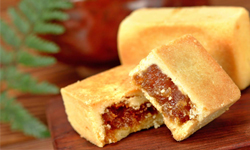 Pineapple is widely grown here in Taiwan, which is also known for producing canned pineapple, pineapple drinks, and pineapple jams. Pineapple is also made into pineapple cake, with the pineapple's sweet and sour taste mingling with the loose, soft outer skin that seems to melt in your mouth; definitely worth giving it a taste... and more!
Pineapple is widely grown here in Taiwan, which is also known for producing canned pineapple, pineapple drinks, and pineapple jams. Pineapple is also made into pineapple cake, with the pineapple's sweet and sour taste mingling with the loose, soft outer skin that seems to melt in your mouth; definitely worth giving it a taste... and more!
Shaoxing and Gaoliang Wines
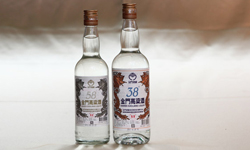 The water quality of the Ailan Plateau, located on the western side of Puli Township, Nantou County, is pure and sweet. Because of the water's unique qualities, it is considered the primary "Shaoxing wine spring." Made by fermenting glutinous rice, Penglai rice, wheat, and other ingredients, the golden yellow Shaoxing wine has a dry, sweet taste.Kinmen, with its hot, dry weather and unpolluted environment, is the best place to make Gaoliang spirit. Thanks to excellent water quality, the Gaoliang produced here is superior in quality and fine in taste. In Matsu, with the uniqueness of the local spring water, brews such as Daqu, Gaoliang, and Matsu Old Wine are most popular. Clear ruby-colored Matsu Old Wine is not just a favored drink on Matsu, but is also widely used in Chinese cooking.
The water quality of the Ailan Plateau, located on the western side of Puli Township, Nantou County, is pure and sweet. Because of the water's unique qualities, it is considered the primary "Shaoxing wine spring." Made by fermenting glutinous rice, Penglai rice, wheat, and other ingredients, the golden yellow Shaoxing wine has a dry, sweet taste.Kinmen, with its hot, dry weather and unpolluted environment, is the best place to make Gaoliang spirit. Thanks to excellent water quality, the Gaoliang produced here is superior in quality and fine in taste. In Matsu, with the uniqueness of the local spring water, brews such as Daqu, Gaoliang, and Matsu Old Wine are most popular. Clear ruby-colored Matsu Old Wine is not just a favored drink on Matsu, but is also widely used in Chinese cooking.
Rice Noodles
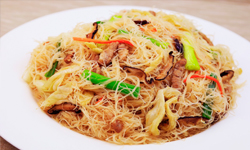 Tradition has it that rice noodles first arrived in Taiwan via Fujian in mainland China. Today, Hsinchu rice noodles and Fengkeng rice noodles are the two best known versions of this popular staple. Hsinchu offers an ideal climate for making rice noodles, which require plenty of sunshine and wind for air drying. The resulting noodles have a springiness that resist mushiness when boiled. The rice noodle industry in Changhua County's Fengkeng Village has roots tracing back over a century. Fengkeng natives have also brought their rice noodle making skills to nearby Puli, helping the township to rise as another well-known spot for rice noodles.The biggest difference between the rice noodles of Hsinchu and Fengkeng comes from the final manufacture steps. The Hsinchu noodles are steam boiled and then air dried to retain more of the original rice taste. The Fengkeng noodles, by comparison, are water boiled before air drying to add to their chewiness. Each version has a unique appeal and mouth-watering taste.
Tradition has it that rice noodles first arrived in Taiwan via Fujian in mainland China. Today, Hsinchu rice noodles and Fengkeng rice noodles are the two best known versions of this popular staple. Hsinchu offers an ideal climate for making rice noodles, which require plenty of sunshine and wind for air drying. The resulting noodles have a springiness that resist mushiness when boiled. The rice noodle industry in Changhua County's Fengkeng Village has roots tracing back over a century. Fengkeng natives have also brought their rice noodle making skills to nearby Puli, helping the township to rise as another well-known spot for rice noodles.The biggest difference between the rice noodles of Hsinchu and Fengkeng comes from the final manufacture steps. The Hsinchu noodles are steam boiled and then air dried to retain more of the original rice taste. The Fengkeng noodles, by comparison, are water boiled before air drying to add to their chewiness. Each version has a unique appeal and mouth-watering taste.
Mochi
 Mochi (sticky rice cake) was called "doushu" (bean rice cake) in early Taiwanese society but later became better known as "mochi" under the influence of the Japanese dessert "wagashi" during the Japanese colonial period. This treat is one of the representative delicacies of Taiwan's aboriginal and Hakka cultures. The Amis "dulun" is a chewy, corn-based version of this treat made without filling.Hakka mochi has come into the spotlight in recent years in large part due to Tseng's Mochi in Hualien. Mr. Tseng moved from western Taiwan to Hualien, where he opened a shop selling traditional Hakka style mochi. Tseng's Mochi is made the traditional way, by hand-grinding the glutinous rice, pressing it dry, and then repeatedly kneading the dough into a dense soft texture that is chewy but not sticky. The fillings have a solid and rich taste that has made the cakes a local favorite and Hualien specialty.
Mochi (sticky rice cake) was called "doushu" (bean rice cake) in early Taiwanese society but later became better known as "mochi" under the influence of the Japanese dessert "wagashi" during the Japanese colonial period. This treat is one of the representative delicacies of Taiwan's aboriginal and Hakka cultures. The Amis "dulun" is a chewy, corn-based version of this treat made without filling.Hakka mochi has come into the spotlight in recent years in large part due to Tseng's Mochi in Hualien. Mr. Tseng moved from western Taiwan to Hualien, where he opened a shop selling traditional Hakka style mochi. Tseng's Mochi is made the traditional way, by hand-grinding the glutinous rice, pressing it dry, and then repeatedly kneading the dough into a dense soft texture that is chewy but not sticky. The fillings have a solid and rich taste that has made the cakes a local favorite and Hualien specialty.
Meat Balls
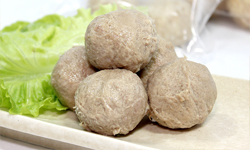 Taiwanese-style meatballs are said to have been invented by a dutiful son who wanted to make an easy-to-eat dish for the family elders. He pulped cube pork and kneaded it into balls, which were boiled in water to create a delicious dish with an al dente texture. Since pork is the main ingredient, this dish was originally called "rouyuan" (meatballs), but later became better known as "gongwan," a name alluding to the pestles (gong) used in their preparation. Hsinchu, where the meatballs originated, continues to enjoy the best reputation for this dish today.
Taiwanese-style meatballs are said to have been invented by a dutiful son who wanted to make an easy-to-eat dish for the family elders. He pulped cube pork and kneaded it into balls, which were boiled in water to create a delicious dish with an al dente texture. Since pork is the main ingredient, this dish was originally called "rouyuan" (meatballs), but later became better known as "gongwan," a name alluding to the pestles (gong) used in their preparation. Hsinchu, where the meatballs originated, continues to enjoy the best reputation for this dish today.
Lei-cha (Ground tea)
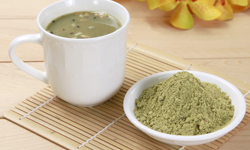 Lei-cha (ground tea) is a traditional tea-based Hakka beverage made with grains, dried fruit, and legumes. These materials are ground, dried into a oil-free powder mixture, and then served with hot water, creating a convenient and healthy dish. Lei-cha is still part of the diet in Hakka communities today and is often served for dinner with a generous garnish of puffed rice and stir-fried side dishes. For most people, however, lei-cha is generally eaten as a banquet refreshment. Authentic style lei-cha can be enjoyed in Beipu Township in Hsinchu County, Nanzhuang Township in Miaoli County, and Meinong District in KaohsiungCity.
Lei-cha (ground tea) is a traditional tea-based Hakka beverage made with grains, dried fruit, and legumes. These materials are ground, dried into a oil-free powder mixture, and then served with hot water, creating a convenient and healthy dish. Lei-cha is still part of the diet in Hakka communities today and is often served for dinner with a generous garnish of puffed rice and stir-fried side dishes. For most people, however, lei-cha is generally eaten as a banquet refreshment. Authentic style lei-cha can be enjoyed in Beipu Township in Hsinchu County, Nanzhuang Township in Miaoli County, and Meinong District in KaohsiungCity.
Sun Cakes
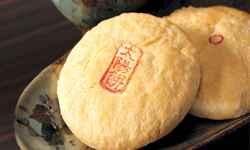 During the early Republican period, Taichung baker Wei Ching-hai improved on a traditional malt cake to create the sun cakes known today. Sun cakes ensconce a malt sugar filling in a golden pastry shell that is formed into a flat round shape approximately the size of a palm for convenient eating. The name comes from their sun-like shape.Sun cakes are also known as "xibing" (fine cakes) due to their delicate texture and popularity as a dessert among the better heeled. They are also known as "paobing" (soaked cakes) due to the common practice of dipping them in hot soymilk to release their malty taste and soften the texture for easier consumption by seniors and children with baby teeth. Taichung is the cradle of sun cakes and home to several old-time bakeries that specialize in making this treat. The cakes are a popular souvenir gift among visitors to central Taiwan.
During the early Republican period, Taichung baker Wei Ching-hai improved on a traditional malt cake to create the sun cakes known today. Sun cakes ensconce a malt sugar filling in a golden pastry shell that is formed into a flat round shape approximately the size of a palm for convenient eating. The name comes from their sun-like shape.Sun cakes are also known as "xibing" (fine cakes) due to their delicate texture and popularity as a dessert among the better heeled. They are also known as "paobing" (soaked cakes) due to the common practice of dipping them in hot soymilk to release their malty taste and soften the texture for easier consumption by seniors and children with baby teeth. Taichung is the cradle of sun cakes and home to several old-time bakeries that specialize in making this treat. The cakes are a popular souvenir gift among visitors to central Taiwan.
Square Biscuits
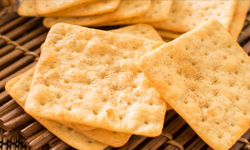 Chiayi's Minguo Road is famous for its noodle and mantou (steamed bun) shops, but it is perhaps best known as the birthplace of square biscuits. Square biscuits are made powdered milk, butter or lard, sesame seeds, and sugar. The dough is baked into fragrant and crispy biscuits and cut into their namesake square shapes.
Chiayi's Minguo Road is famous for its noodle and mantou (steamed bun) shops, but it is perhaps best known as the birthplace of square biscuits. Square biscuits are made powdered milk, butter or lard, sesame seeds, and sugar. The dough is baked into fragrant and crispy biscuits and cut into their namesake square shapes.
Coffee
 Coffee has been cultivated in Taiwan since the Japanese colonial period. The industry subsequently fell into decline due to high export costs and competition from Central and South America, but in recent years coffee has been making a resurgence in Taiwan.One of the best-known coffee growing areas in Taiwan is Gukeng Township in Yunlin County. Gukeng coffee is cultivated in the Hebao Mountain, Huashan, Huanan, Guilin, and Zhanghu areas at altitudes ranging from 200 to 800 meters above sea level. Abundant sunshine and rain, good drainage, and soil rich in potassium carbonate create ideal conditions for coffee growing, placing Gukeng coffee among Taiwan's famous local products. Dongshan District in Tainan City has also been vigorously promoting its coffee industry with local government support. The main coffee growing area here is Kantou Mountain in Nanshi Village and Gaoyuan Village. A local coffee festival has further boosted the popularity of the local beans.
Coffee has been cultivated in Taiwan since the Japanese colonial period. The industry subsequently fell into decline due to high export costs and competition from Central and South America, but in recent years coffee has been making a resurgence in Taiwan.One of the best-known coffee growing areas in Taiwan is Gukeng Township in Yunlin County. Gukeng coffee is cultivated in the Hebao Mountain, Huashan, Huanan, Guilin, and Zhanghu areas at altitudes ranging from 200 to 800 meters above sea level. Abundant sunshine and rain, good drainage, and soil rich in potassium carbonate create ideal conditions for coffee growing, placing Gukeng coffee among Taiwan's famous local products. Dongshan District in Tainan City has also been vigorously promoting its coffee industry with local government support. The main coffee growing area here is Kantou Mountain in Nanshi Village and Gaoyuan Village. A local coffee festival has further boosted the popularity of the local beans.
Kumquat Preserves
 Kumquat preserves are a well-known Taiwan specialty. The kumquat variety used in making this treat originally came from Oujiang County in Zhejiang Province and in Taiwan is grown most widely in the Yilan area. The townships of Jiaoxi, Yuanshan, and Sanxing are also major growing areas for kumquats thanks to their rainy climate, good drainage, and shelter from sea winds and storms, resulting in local yields as high as 90%. The fruit is harvested from November to February, with peak production in December and January. Kumquat rinds have a tangy taste with a natural sweet finish. They also promote salivation, help digestion, and sooth the throat, making them a popular snack and refreshment.
Kumquat preserves are a well-known Taiwan specialty. The kumquat variety used in making this treat originally came from Oujiang County in Zhejiang Province and in Taiwan is grown most widely in the Yilan area. The townships of Jiaoxi, Yuanshan, and Sanxing are also major growing areas for kumquats thanks to their rainy climate, good drainage, and shelter from sea winds and storms, resulting in local yields as high as 90%. The fruit is harvested from November to February, with peak production in December and January. Kumquat rinds have a tangy taste with a natural sweet finish. They also promote salivation, help digestion, and sooth the throat, making them a popular snack and refreshment.
Mullet Roe
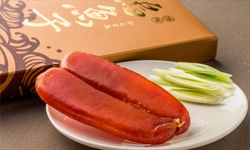 Mullet roe processing has a history of over a hundred years in Taiwan. Production begins with the selection of female mullet and removal of the roe. The roe is then cleaned, drained of blood, salted, desalted, pressed, dried, and then shaped in a process that takes about a week. The quality of mullet roe can be judged from its appearance and taste. High-quality mullet roe has an attractive color, uniform thickness, and translucence; and the taste and texture are well balanced in terms of saltiness, moisture level, and hardness. In Taiwan, this popular delicacy is generally roasted and flavored with sorghum wine. Mullet roe can be purchased at most department stores and specialty shops. It is especially popular as a gift during the Lunar New Year and other festivities.
Mullet roe processing has a history of over a hundred years in Taiwan. Production begins with the selection of female mullet and removal of the roe. The roe is then cleaned, drained of blood, salted, desalted, pressed, dried, and then shaped in a process that takes about a week. The quality of mullet roe can be judged from its appearance and taste. High-quality mullet roe has an attractive color, uniform thickness, and translucence; and the taste and texture are well balanced in terms of saltiness, moisture level, and hardness. In Taiwan, this popular delicacy is generally roasted and flavored with sorghum wine. Mullet roe can be purchased at most department stores and specialty shops. It is especially popular as a gift during the Lunar New Year and other festivities.
Brown Sugar Cake
 Brown sugar cake evolved from a type of steamed sponge cake presented as an ancestral offering. The brown sugar version is believed to have been brought to Penghu by early immigrants from Okinawa, an island well known for its brown sugar. The brown sugar cake famous in Penghu today was first produced by a Ryukyu baker surnamed Maruhachi.While brown sugar cake was originally used strictly as an offering, local bakeries now make this treat to meet growing tourist demand. Made with new techniques, the cakes today are softer and less sugary than their predecessors. They are also beautifully packaged, making them a popular souvenir gift in Penghu.
Brown sugar cake evolved from a type of steamed sponge cake presented as an ancestral offering. The brown sugar version is believed to have been brought to Penghu by early immigrants from Okinawa, an island well known for its brown sugar. The brown sugar cake famous in Penghu today was first produced by a Ryukyu baker surnamed Maruhachi.While brown sugar cake was originally used strictly as an offering, local bakeries now make this treat to meet growing tourist demand. Made with new techniques, the cakes today are softer and less sugary than their predecessors. They are also beautifully packaged, making them a popular souvenir gift in Penghu.
Jiguang Bread
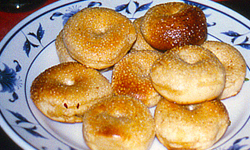 According to legend, this bagel-like bread was invented by the Ming dynasty General Chi Chi-kuang as an easy-to-transport military ration since the bread could be strung together and carried around the neck. The bread is made with naturally leavened dough that is carefully kneaded to produce a solid and chewy bread. The dough is baked by sticking it to an oven wall. The oven walls can't get to hot or the bread will peel off and be ruined. The Matsu variety of jiguang bread is faithful to the northern Chinese style. The breads were originally served deep-fried, but a healthier oven-baked version now prevails. The bread is often served with ham and fried egg like a hamburger, and is therefore commonly known as a "Matsu hamburger."
According to legend, this bagel-like bread was invented by the Ming dynasty General Chi Chi-kuang as an easy-to-transport military ration since the bread could be strung together and carried around the neck. The bread is made with naturally leavened dough that is carefully kneaded to produce a solid and chewy bread. The dough is baked by sticking it to an oven wall. The oven walls can't get to hot or the bread will peel off and be ruined. The Matsu variety of jiguang bread is faithful to the northern Chinese style. The breads were originally served deep-fried, but a healthier oven-baked version now prevails. The bread is often served with ham and fried egg like a hamburger, and is therefore commonly known as a "Matsu hamburger."
Ox Tongue Biscuits
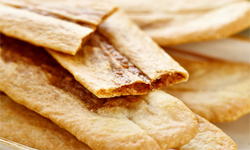 These popular biscuits are named after their long, oval tongue-like shape. Yilan and Lugang are the best know areas for ox tongue biscuits in Taiwan. The two varieties, though similar in appearance, are in fact two distinct treats that reflect the different environments of the their birthplaces.Yilan ox tongue biscuits are long, narrow, and thin. The ingredients are kneaded by hand into a dough, rolled flat, tapped down the center with a knife, and then baked to a crispy biscuit-like texture. The Lugang version, on the other hand, is thick and oval-shaped. The biscuits are flaky and lightly sweetened with a malt sugar filling and baked or fried.
These popular biscuits are named after their long, oval tongue-like shape. Yilan and Lugang are the best know areas for ox tongue biscuits in Taiwan. The two varieties, though similar in appearance, are in fact two distinct treats that reflect the different environments of the their birthplaces.Yilan ox tongue biscuits are long, narrow, and thin. The ingredients are kneaded by hand into a dough, rolled flat, tapped down the center with a knife, and then baked to a crispy biscuit-like texture. The Lugang version, on the other hand, is thick and oval-shaped. The biscuits are flaky and lightly sweetened with a malt sugar filling and baked or fried.
 Oil noodles and bean sprouts are the main ingredients in this Tainan specialty dish. The noodles are served in a small bowl and usually topped with meat or an egg boiled in soy sauce for an extra flavor boost.
Oil noodles and bean sprouts are the main ingredients in this Tainan specialty dish. The noodles are served in a small bowl and usually topped with meat or an egg boiled in soy sauce for an extra flavor boost. With seas on all side, Taiwan enjoys a bounty of seafood that is served up in a wide variety of snack foods that have become ingrained in the culinary tradition of the island. One of these dishes is shrimp pork soup, which has become a night market mainstay. This dish is made mostly of shrimp potage flavored with stewed pork and a thickening dash of potato starch to add flavor and chewiness. Add a splash of black vinegar to increase the sweetness of the soup and make this tasty dish even more delicious.
With seas on all side, Taiwan enjoys a bounty of seafood that is served up in a wide variety of snack foods that have become ingrained in the culinary tradition of the island. One of these dishes is shrimp pork soup, which has become a night market mainstay. This dish is made mostly of shrimp potage flavored with stewed pork and a thickening dash of potato starch to add flavor and chewiness. Add a splash of black vinegar to increase the sweetness of the soup and make this tasty dish even more delicious. This Tainan specialty often turns peoples’ heads for its very unusual name. The sandwich is a thick slice of toast with a hollow center filled with a mixture of chicken meat and liver, shrimp, carrots, potatoes, and milk. The filling is then covered with another piece of toast and cut into four pieces. The coffin board tastes best when served hot.
This Tainan specialty often turns peoples’ heads for its very unusual name. The sandwich is a thick slice of toast with a hollow center filled with a mixture of chicken meat and liver, shrimp, carrots, potatoes, and milk. The filling is then covered with another piece of toast and cut into four pieces. The coffin board tastes best when served hot. Changhua and Hsinchu counties are the most famous places for Taiwanese meatballs. The meatballs are cooked in an outer wrapper made of tapioca powder, rice powder, potato starch, and water, while the filling includes pork, mushroom, bamboo shoots and other ingredients. The chewy outer skin and fragrant filling make a perfectly delicious match.
Changhua and Hsinchu counties are the most famous places for Taiwanese meatballs. The meatballs are cooked in an outer wrapper made of tapioca powder, rice powder, potato starch, and water, while the filling includes pork, mushroom, bamboo shoots and other ingredients. The chewy outer skin and fragrant filling make a perfectly delicious match. Steamed sandwiches ("guabao") were originally eaten during employee dinner parties held on the 16th day of the 12th lunar month, but today they can be enjoyed at night markets throughout the year. The sandwiches resemble a kind of hamburger made with a soft white bun. The bun is stuffed with melt-in-your-mouth pork and garnished with pickled vegetables, peanut powder and cilantro, creating a nose-pleasing and tasty combination.
Steamed sandwiches ("guabao") were originally eaten during employee dinner parties held on the 16th day of the 12th lunar month, but today they can be enjoyed at night markets throughout the year. The sandwiches resemble a kind of hamburger made with a soft white bun. The bun is stuffed with melt-in-your-mouth pork and garnished with pickled vegetables, peanut powder and cilantro, creating a nose-pleasing and tasty combination. Stinky tofu is known as "the stronger the smell, the tastier the results." And while many people are put off by the smell, those who take the plunge are usually won over by this distinctively yummy treat. Stinky tofu is made of large squares of fermented tofu fried in oil and then cut into four smaller pieces and served with a garnish of pickled cabbage. The crispy skin of the tofu and the soft inside are the best parts of this dish's charm.
Stinky tofu is known as "the stronger the smell, the tastier the results." And while many people are put off by the smell, those who take the plunge are usually won over by this distinctively yummy treat. Stinky tofu is made of large squares of fermented tofu fried in oil and then cut into four smaller pieces and served with a garnish of pickled cabbage. The crispy skin of the tofu and the soft inside are the best parts of this dish's charm.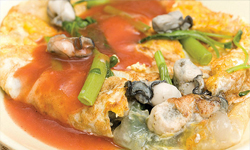 Sea-fresh oysters are an important ingredient in this popular snack, available at just about every night market in Taiwan. The oysters are coated in potato starch and tapioca. Eggs and leafy vegetables are added to the mixture, which is skillet fried over a high flame. A sweet and sour sauce further adds to the addictively delicious taste.
Sea-fresh oysters are an important ingredient in this popular snack, available at just about every night market in Taiwan. The oysters are coated in potato starch and tapioca. Eggs and leafy vegetables are added to the mixture, which is skillet fried over a high flame. A sweet and sour sauce further adds to the addictively delicious taste.








 Also known as "Bubble milk tea," pearl milk tea originates from Taichung and is made of a mixture of black tea, milk, and sago pearls. The combination of fragrant tea and chewy sago has made this beverage popular not only in Taiwan but in other countries as well. In many Chinatowns across the world, you can find this refreshing beverage.
Also known as "Bubble milk tea," pearl milk tea originates from Taichung and is made of a mixture of black tea, milk, and sago pearls. The combination of fragrant tea and chewy sago has made this beverage popular not only in Taiwan but in other countries as well. In many Chinatowns across the world, you can find this refreshing beverage.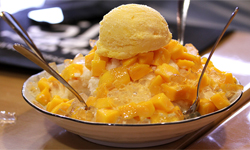 This popular dessert has a base of crushed ice flavored with mung beans, adzuki beans, starch balls, taro, jelly, and other toppings, which are sprinkled with sugar water, offering sweet and cool relief on a hot summer day. Today, you can also find creative new variations with toppings of mangoes, strawberries and other seasonal fruit.
This popular dessert has a base of crushed ice flavored with mung beans, adzuki beans, starch balls, taro, jelly, and other toppings, which are sprinkled with sugar water, offering sweet and cool relief on a hot summer day. Today, you can also find creative new variations with toppings of mangoes, strawberries and other seasonal fruit. With a reputation of being a tea empire, Taiwan has topography and climate that are perfect for growing tea plants. There are many varieties of tea available in Taiwan; among these, Wenshan Baozhong Tea, Dongding Oolong (Wulong) Tea, Pekoe Oolong (Baihao Wulong) Tea, and Tie Guanyin are the four mainstream teas.You can pick up virtually any type of teapot in department stores or tea stores. If you want to buy a piece of porcelain culture aside from having a teapot to boil tea in, go to Yingge, the ceramics capital of Taiwan.Yingge's Jianshanpu Rd. is a newly designed pedestrian area, and the whole shopping area provides various types of porcelain products. This is the best place to buy your teapot and have a look around.Major department stores and supermarkets have special stalls that sell tea, which makes this national beverage readily available.Besides,there is also the tea bag, a simple and convenient way to enjoy a cup of tea.
With a reputation of being a tea empire, Taiwan has topography and climate that are perfect for growing tea plants. There are many varieties of tea available in Taiwan; among these, Wenshan Baozhong Tea, Dongding Oolong (Wulong) Tea, Pekoe Oolong (Baihao Wulong) Tea, and Tie Guanyin are the four mainstream teas.You can pick up virtually any type of teapot in department stores or tea stores. If you want to buy a piece of porcelain culture aside from having a teapot to boil tea in, go to Yingge, the ceramics capital of Taiwan.Yingge's Jianshanpu Rd. is a newly designed pedestrian area, and the whole shopping area provides various types of porcelain products. This is the best place to buy your teapot and have a look around.Major department stores and supermarkets have special stalls that sell tea, which makes this national beverage readily available.Besides,there is also the tea bag, a simple and convenient way to enjoy a cup of tea. Pineapple is widely grown here in Taiwan, which is also known for producing canned pineapple, pineapple drinks, and pineapple jams. Pineapple is also made into pineapple cake, with the pineapple's sweet and sour taste mingling with the loose, soft outer skin that seems to melt in your mouth; definitely worth giving it a taste... and more!
Pineapple is widely grown here in Taiwan, which is also known for producing canned pineapple, pineapple drinks, and pineapple jams. Pineapple is also made into pineapple cake, with the pineapple's sweet and sour taste mingling with the loose, soft outer skin that seems to melt in your mouth; definitely worth giving it a taste... and more! The water quality of the Ailan Plateau, located on the western side of Puli Township, Nantou County, is pure and sweet. Because of the water's unique qualities, it is considered the primary "Shaoxing wine spring." Made by fermenting glutinous rice, Penglai rice, wheat, and other ingredients, the golden yellow Shaoxing wine has a dry, sweet taste.Kinmen, with its hot, dry weather and unpolluted environment, is the best place to make Gaoliang spirit. Thanks to excellent water quality, the Gaoliang produced here is superior in quality and fine in taste. In Matsu, with the uniqueness of the local spring water, brews such as Daqu, Gaoliang, and Matsu Old Wine are most popular. Clear ruby-colored Matsu Old Wine is not just a favored drink on Matsu, but is also widely used in Chinese cooking.
The water quality of the Ailan Plateau, located on the western side of Puli Township, Nantou County, is pure and sweet. Because of the water's unique qualities, it is considered the primary "Shaoxing wine spring." Made by fermenting glutinous rice, Penglai rice, wheat, and other ingredients, the golden yellow Shaoxing wine has a dry, sweet taste.Kinmen, with its hot, dry weather and unpolluted environment, is the best place to make Gaoliang spirit. Thanks to excellent water quality, the Gaoliang produced here is superior in quality and fine in taste. In Matsu, with the uniqueness of the local spring water, brews such as Daqu, Gaoliang, and Matsu Old Wine are most popular. Clear ruby-colored Matsu Old Wine is not just a favored drink on Matsu, but is also widely used in Chinese cooking. Tradition has it that rice noodles first arrived in Taiwan via Fujian in mainland China. Today, Hsinchu rice noodles and Fengkeng rice noodles are the two best known versions of this popular staple. Hsinchu offers an ideal climate for making rice noodles, which require plenty of sunshine and wind for air drying. The resulting noodles have a springiness that resist mushiness when boiled. The rice noodle industry in Changhua County's Fengkeng Village has roots tracing back over a century. Fengkeng natives have also brought their rice noodle making skills to nearby Puli, helping the township to rise as another well-known spot for rice noodles.The biggest difference between the rice noodles of Hsinchu and Fengkeng comes from the final manufacture steps. The Hsinchu noodles are steam boiled and then air dried to retain more of the original rice taste. The Fengkeng noodles, by comparison, are water boiled before air drying to add to their chewiness. Each version has a unique appeal and mouth-watering taste.
Tradition has it that rice noodles first arrived in Taiwan via Fujian in mainland China. Today, Hsinchu rice noodles and Fengkeng rice noodles are the two best known versions of this popular staple. Hsinchu offers an ideal climate for making rice noodles, which require plenty of sunshine and wind for air drying. The resulting noodles have a springiness that resist mushiness when boiled. The rice noodle industry in Changhua County's Fengkeng Village has roots tracing back over a century. Fengkeng natives have also brought their rice noodle making skills to nearby Puli, helping the township to rise as another well-known spot for rice noodles.The biggest difference between the rice noodles of Hsinchu and Fengkeng comes from the final manufacture steps. The Hsinchu noodles are steam boiled and then air dried to retain more of the original rice taste. The Fengkeng noodles, by comparison, are water boiled before air drying to add to their chewiness. Each version has a unique appeal and mouth-watering taste. Mochi (sticky rice cake) was called "doushu" (bean rice cake) in early Taiwanese society but later became better known as "mochi" under the influence of the Japanese dessert "wagashi" during the Japanese colonial period. This treat is one of the representative delicacies of Taiwan's aboriginal and Hakka cultures. The Amis "dulun" is a chewy, corn-based version of this treat made without filling.Hakka mochi has come into the spotlight in recent years in large part due to Tseng's Mochi in Hualien. Mr. Tseng moved from western Taiwan to Hualien, where he opened a shop selling traditional Hakka style mochi. Tseng's Mochi is made the traditional way, by hand-grinding the glutinous rice, pressing it dry, and then repeatedly kneading the dough into a dense soft texture that is chewy but not sticky. The fillings have a solid and rich taste that has made the cakes a local favorite and Hualien specialty.
Mochi (sticky rice cake) was called "doushu" (bean rice cake) in early Taiwanese society but later became better known as "mochi" under the influence of the Japanese dessert "wagashi" during the Japanese colonial period. This treat is one of the representative delicacies of Taiwan's aboriginal and Hakka cultures. The Amis "dulun" is a chewy, corn-based version of this treat made without filling.Hakka mochi has come into the spotlight in recent years in large part due to Tseng's Mochi in Hualien. Mr. Tseng moved from western Taiwan to Hualien, where he opened a shop selling traditional Hakka style mochi. Tseng's Mochi is made the traditional way, by hand-grinding the glutinous rice, pressing it dry, and then repeatedly kneading the dough into a dense soft texture that is chewy but not sticky. The fillings have a solid and rich taste that has made the cakes a local favorite and Hualien specialty. Taiwanese-style meatballs are said to have been invented by a dutiful son who wanted to make an easy-to-eat dish for the family elders. He pulped cube pork and kneaded it into balls, which were boiled in water to create a delicious dish with an al dente texture. Since pork is the main ingredient, this dish was originally called "rouyuan" (meatballs), but later became better known as "gongwan," a name alluding to the pestles (gong) used in their preparation. Hsinchu, where the meatballs originated, continues to enjoy the best reputation for this dish today.
Taiwanese-style meatballs are said to have been invented by a dutiful son who wanted to make an easy-to-eat dish for the family elders. He pulped cube pork and kneaded it into balls, which were boiled in water to create a delicious dish with an al dente texture. Since pork is the main ingredient, this dish was originally called "rouyuan" (meatballs), but later became better known as "gongwan," a name alluding to the pestles (gong) used in their preparation. Hsinchu, where the meatballs originated, continues to enjoy the best reputation for this dish today. Lei-cha (ground tea) is a traditional tea-based Hakka beverage made with grains, dried fruit, and legumes. These materials are ground, dried into a oil-free powder mixture, and then served with hot water, creating a convenient and healthy dish. Lei-cha is still part of the diet in Hakka communities today and is often served for dinner with a generous garnish of puffed rice and stir-fried side dishes. For most people, however, lei-cha is generally eaten as a banquet refreshment. Authentic style lei-cha can be enjoyed in Beipu Township in Hsinchu County, Nanzhuang Township in Miaoli County, and Meinong District in KaohsiungCity.
Lei-cha (ground tea) is a traditional tea-based Hakka beverage made with grains, dried fruit, and legumes. These materials are ground, dried into a oil-free powder mixture, and then served with hot water, creating a convenient and healthy dish. Lei-cha is still part of the diet in Hakka communities today and is often served for dinner with a generous garnish of puffed rice and stir-fried side dishes. For most people, however, lei-cha is generally eaten as a banquet refreshment. Authentic style lei-cha can be enjoyed in Beipu Township in Hsinchu County, Nanzhuang Township in Miaoli County, and Meinong District in KaohsiungCity. During the early Republican period, Taichung baker Wei Ching-hai improved on a traditional malt cake to create the sun cakes known today. Sun cakes ensconce a malt sugar filling in a golden pastry shell that is formed into a flat round shape approximately the size of a palm for convenient eating. The name comes from their sun-like shape.Sun cakes are also known as "xibing" (fine cakes) due to their delicate texture and popularity as a dessert among the better heeled. They are also known as "paobing" (soaked cakes) due to the common practice of dipping them in hot soymilk to release their malty taste and soften the texture for easier consumption by seniors and children with baby teeth. Taichung is the cradle of sun cakes and home to several old-time bakeries that specialize in making this treat. The cakes are a popular souvenir gift among visitors to central Taiwan.
During the early Republican period, Taichung baker Wei Ching-hai improved on a traditional malt cake to create the sun cakes known today. Sun cakes ensconce a malt sugar filling in a golden pastry shell that is formed into a flat round shape approximately the size of a palm for convenient eating. The name comes from their sun-like shape.Sun cakes are also known as "xibing" (fine cakes) due to their delicate texture and popularity as a dessert among the better heeled. They are also known as "paobing" (soaked cakes) due to the common practice of dipping them in hot soymilk to release their malty taste and soften the texture for easier consumption by seniors and children with baby teeth. Taichung is the cradle of sun cakes and home to several old-time bakeries that specialize in making this treat. The cakes are a popular souvenir gift among visitors to central Taiwan. Chiayi's Minguo Road is famous for its noodle and mantou (steamed bun) shops, but it is perhaps best known as the birthplace of square biscuits. Square biscuits are made powdered milk, butter or lard, sesame seeds, and sugar. The dough is baked into fragrant and crispy biscuits and cut into their namesake square shapes.
Chiayi's Minguo Road is famous for its noodle and mantou (steamed bun) shops, but it is perhaps best known as the birthplace of square biscuits. Square biscuits are made powdered milk, butter or lard, sesame seeds, and sugar. The dough is baked into fragrant and crispy biscuits and cut into their namesake square shapes. Coffee has been cultivated in Taiwan since the Japanese colonial period. The industry subsequently fell into decline due to high export costs and competition from Central and South America, but in recent years coffee has been making a resurgence in Taiwan.One of the best-known coffee growing areas in Taiwan is Gukeng Township in Yunlin County. Gukeng coffee is cultivated in the Hebao Mountain, Huashan, Huanan, Guilin, and Zhanghu areas at altitudes ranging from 200 to 800 meters above sea level. Abundant sunshine and rain, good drainage, and soil rich in potassium carbonate create ideal conditions for coffee growing, placing Gukeng coffee among Taiwan's famous local products. Dongshan District in Tainan City has also been vigorously promoting its coffee industry with local government support. The main coffee growing area here is Kantou Mountain in Nanshi Village and Gaoyuan Village. A local coffee festival has further boosted the popularity of the local beans.
Coffee has been cultivated in Taiwan since the Japanese colonial period. The industry subsequently fell into decline due to high export costs and competition from Central and South America, but in recent years coffee has been making a resurgence in Taiwan.One of the best-known coffee growing areas in Taiwan is Gukeng Township in Yunlin County. Gukeng coffee is cultivated in the Hebao Mountain, Huashan, Huanan, Guilin, and Zhanghu areas at altitudes ranging from 200 to 800 meters above sea level. Abundant sunshine and rain, good drainage, and soil rich in potassium carbonate create ideal conditions for coffee growing, placing Gukeng coffee among Taiwan's famous local products. Dongshan District in Tainan City has also been vigorously promoting its coffee industry with local government support. The main coffee growing area here is Kantou Mountain in Nanshi Village and Gaoyuan Village. A local coffee festival has further boosted the popularity of the local beans. Kumquat preserves are a well-known Taiwan specialty. The kumquat variety used in making this treat originally came from Oujiang County in Zhejiang Province and in Taiwan is grown most widely in the Yilan area. The townships of Jiaoxi, Yuanshan, and Sanxing are also major growing areas for kumquats thanks to their rainy climate, good drainage, and shelter from sea winds and storms, resulting in local yields as high as 90%. The fruit is harvested from November to February, with peak production in December and January. Kumquat rinds have a tangy taste with a natural sweet finish. They also promote salivation, help digestion, and sooth the throat, making them a popular snack and refreshment.
Kumquat preserves are a well-known Taiwan specialty. The kumquat variety used in making this treat originally came from Oujiang County in Zhejiang Province and in Taiwan is grown most widely in the Yilan area. The townships of Jiaoxi, Yuanshan, and Sanxing are also major growing areas for kumquats thanks to their rainy climate, good drainage, and shelter from sea winds and storms, resulting in local yields as high as 90%. The fruit is harvested from November to February, with peak production in December and January. Kumquat rinds have a tangy taste with a natural sweet finish. They also promote salivation, help digestion, and sooth the throat, making them a popular snack and refreshment. Mullet roe processing has a history of over a hundred years in Taiwan. Production begins with the selection of female mullet and removal of the roe. The roe is then cleaned, drained of blood, salted, desalted, pressed, dried, and then shaped in a process that takes about a week. The quality of mullet roe can be judged from its appearance and taste. High-quality mullet roe has an attractive color, uniform thickness, and translucence; and the taste and texture are well balanced in terms of saltiness, moisture level, and hardness. In Taiwan, this popular delicacy is generally roasted and flavored with sorghum wine. Mullet roe can be purchased at most department stores and specialty shops. It is especially popular as a gift during the Lunar New Year and other festivities.
Mullet roe processing has a history of over a hundred years in Taiwan. Production begins with the selection of female mullet and removal of the roe. The roe is then cleaned, drained of blood, salted, desalted, pressed, dried, and then shaped in a process that takes about a week. The quality of mullet roe can be judged from its appearance and taste. High-quality mullet roe has an attractive color, uniform thickness, and translucence; and the taste and texture are well balanced in terms of saltiness, moisture level, and hardness. In Taiwan, this popular delicacy is generally roasted and flavored with sorghum wine. Mullet roe can be purchased at most department stores and specialty shops. It is especially popular as a gift during the Lunar New Year and other festivities. Brown sugar cake evolved from a type of steamed sponge cake presented as an ancestral offering. The brown sugar version is believed to have been brought to Penghu by early immigrants from Okinawa, an island well known for its brown sugar. The brown sugar cake famous in Penghu today was first produced by a Ryukyu baker surnamed Maruhachi.While brown sugar cake was originally used strictly as an offering, local bakeries now make this treat to meet growing tourist demand. Made with new techniques, the cakes today are softer and less sugary than their predecessors. They are also beautifully packaged, making them a popular souvenir gift in Penghu.
Brown sugar cake evolved from a type of steamed sponge cake presented as an ancestral offering. The brown sugar version is believed to have been brought to Penghu by early immigrants from Okinawa, an island well known for its brown sugar. The brown sugar cake famous in Penghu today was first produced by a Ryukyu baker surnamed Maruhachi.While brown sugar cake was originally used strictly as an offering, local bakeries now make this treat to meet growing tourist demand. Made with new techniques, the cakes today are softer and less sugary than their predecessors. They are also beautifully packaged, making them a popular souvenir gift in Penghu. According to legend, this bagel-like bread was invented by the Ming dynasty General Chi Chi-kuang as an easy-to-transport military ration since the bread could be strung together and carried around the neck. The bread is made with naturally leavened dough that is carefully kneaded to produce a solid and chewy bread. The dough is baked by sticking it to an oven wall. The oven walls can't get to hot or the bread will peel off and be ruined. The Matsu variety of jiguang bread is faithful to the northern Chinese style. The breads were originally served deep-fried, but a healthier oven-baked version now prevails. The bread is often served with ham and fried egg like a hamburger, and is therefore commonly known as a "Matsu hamburger."
According to legend, this bagel-like bread was invented by the Ming dynasty General Chi Chi-kuang as an easy-to-transport military ration since the bread could be strung together and carried around the neck. The bread is made with naturally leavened dough that is carefully kneaded to produce a solid and chewy bread. The dough is baked by sticking it to an oven wall. The oven walls can't get to hot or the bread will peel off and be ruined. The Matsu variety of jiguang bread is faithful to the northern Chinese style. The breads were originally served deep-fried, but a healthier oven-baked version now prevails. The bread is often served with ham and fried egg like a hamburger, and is therefore commonly known as a "Matsu hamburger." These popular biscuits are named after their long, oval tongue-like shape. Yilan and Lugang are the best know areas for ox tongue biscuits in Taiwan. The two varieties, though similar in appearance, are in fact two distinct treats that reflect the different environments of the their birthplaces.Yilan ox tongue biscuits are long, narrow, and thin. The ingredients are kneaded by hand into a dough, rolled flat, tapped down the center with a knife, and then baked to a crispy biscuit-like texture. The Lugang version, on the other hand, is thick and oval-shaped. The biscuits are flaky and lightly sweetened with a malt sugar filling and baked or fried.
These popular biscuits are named after their long, oval tongue-like shape. Yilan and Lugang are the best know areas for ox tongue biscuits in Taiwan. The two varieties, though similar in appearance, are in fact two distinct treats that reflect the different environments of the their birthplaces.Yilan ox tongue biscuits are long, narrow, and thin. The ingredients are kneaded by hand into a dough, rolled flat, tapped down the center with a knife, and then baked to a crispy biscuit-like texture. The Lugang version, on the other hand, is thick and oval-shaped. The biscuits are flaky and lightly sweetened with a malt sugar filling and baked or fried.